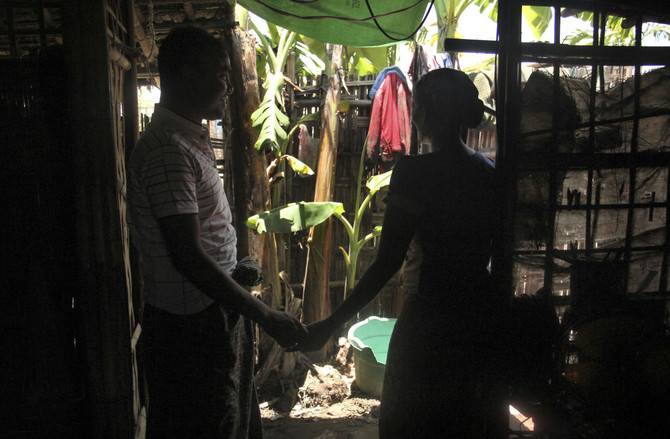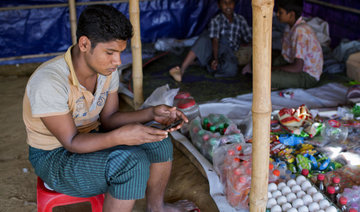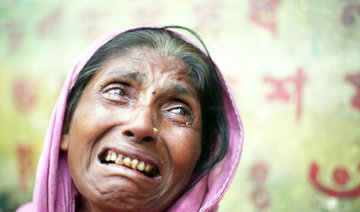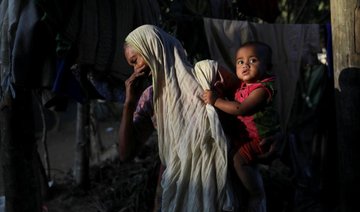THETKABYIN, Myanmar: In her dreams, Setara walks hand in hand with her Muslim husband through the streets of the seaside Myanmar town they grew up in. They visit old friends, share a meal with family, dip their toes into the warm surf of the Bay of Bengal.
But in the hate-filled reality of the world they live in, Setara can only do these things alone — when she takes off her Islamic veil and crosses through a pair of checkpoints into the predominantly Buddhist state capital, where her government will not allow the love of her life to set foot.
That’s because Setara’s husband is an ethnic Rohingya Muslim, a group the UN has called one of the most persecuted on the planet. Setara, meanwhile, was born a Buddhist and part of the ethnic Rakhine, who despise the Rohingya and see them as foreign invaders from Bangladesh.
Marriage between the two communities is extraordinarily rare. It’s also risky in a nation where security forces have driven more than 730,000 Rohingya into exile since 2016, carried out large-scale massacres and burned hundreds of villages in a campaign the UN and human rights groups have described as “ethnic cleansing.”
In Sittwe, Setara tells no one she is married to a Rohingya. Because “if they knew, they would kill me right away. So I’m always careful.”
The 24-year-old’s fears are not exaggerated. Even Rohingya who have ventured into Sittwe on rare trips escorted by police in recent months have been attacked by mobs and killed. Hard-line Buddhists regularly march through the city’s crumbling streets, past ruined mosques that have been closed since June 2012, when the Rakhine burned most Rohingya homes and drove more than 120,000 into camps for the displaced.
Setara, then a widow, met her husband, Mohammad, about eight months later at a market on the edge of a Rohingya village where she had come to sell vegetables. Rakhine traders, who can travel freely, regularly sell goods to Rohingya at marked-up prices.
They exchanged phone numbers and she began visiting him at a pharmacy he ran nearby. Mohammad, 32, bought her small gifts, teased her to make her laugh and took her for rides on his motorbike. He was amazed to meet a Rakhine woman who didn’t treat a Rohingya any differently than her own. He told her he loved her.
Setara felt the same way. She thought he was the kindest man she had ever known.
But when she told her family — after much reluctance — that she was dating a Rohingya man, they became enraged. Her brother beat her severely. They told her she could not go back. Then, her family kicked her out.
The move pushed her closer to Mohammad. In late 2013, she converted to Islam and they married in a small Islamic ceremony held before local religious leaders. No one from Setara’s family attended.
In the years since, Setara has reconciled with her three sisters. But she has never been able to return home. Her parents passed away when she was young, and the brother who helped raise them all still refuses to speak to her. Residents of her old neighborhood have also made clear she is no longer welcome; they call her a “Kalar’s wife.” Kalar is a derogatory word for Muslims that is frequently used in Myanmar.
Mohammad characterizes their relationship in much the same way his wife does. “She sees me as a human being and I see her as a human being, and it’s that simple,” he said, when asked how they had overcome the huge societal obstacles to marry.
Mohammad is a quiet man with a calm manner; Setara is more outspoken. They are a couple clearly in love, glancing at each other and smiling as they talk. The AP is identifying them by their first names only for their protection.
They live in a Rohingya village adjacent to a network of Muslim displaced camps, with Setara’s 2-year-old niece and her 9-year-old daughter from her first marriage. Setara says the Rohingya have welcomed her warmly, as one of their own. But she misses her old friends and her old life.
While Mohammad, like all Rohingya, is not permitted by the government to travel, Setara makes regular trips to Sittwe, about half an hour away, to buy supplies for the small pharmacy and shop they run beside their home.
Before going, though, she smears a pale cosmetic paste on her cheeks called “thanaka,” which is commonly used by Buddhists in Myanmar. She takes off her veil and puts on a blouse. And she never forgets to bring her national identification card, which includes a critical line indicating she is Buddhist. Without it, she could never cross the checkpoints — one manned by police, the other by soldiers — to town.
The contrast between the two worlds is startling. The Rohingya side is dry and dusty, devoid of trees and filled with despair, with little to do. The Buddhist side is lush, with schools and a university, paved roads, a karaoke bar and restaurants that serve wine by the sea.
In Sittwe’s main market, Setara visits friends and sometimes her sisters. But she also overhears Rakhine gossiping about the latest news, and cursing the Rohingya.
Sometimes she goes to the beach, where teens hang out at seaside cafes on plastic chairs, and watches the sun go down. But when she thinks about her husband — the fact that he cannot be there — her thoughts turn dark, and she wonders “if our lives will just end like this.”
“I always wish I could go out with my husband and go to the fun places in town ... especially when I see other couples going around,” Setara said. “I just want to cry sometimes.”
Mohammad imagines the same, impossible trips. But he also worries each time she goes. “I worry something might happen, that someone might find out she’s a Muslim, that she’s married to me,” he said.
Both said they want children of their own because they love each other. But they know it would not be easy for a child, who would be half Rohingya and not recognized as a Burmese citizen.
The marriage has given Setara a profound insight into life in the camps for the Rohingya displaced.
“It’s just like hell,” she said. “They have no hope. They have no medical treatment. People are more and more scared.”
Since Rohingya insurgents staged dozens of attacks in the northern half of Rakhine state that triggered a major backlash by security forces in late August, life in the south, where Setara and her husband live, has stayed calm but only gotten harder.
International aid for displaced camps has been held up by authorities, and humanitarian workers have been forced to scale back visits. Hussein said the government has also stopped Rohingya from fishing, a critical source of income, until they accept “national verification cards” which identify them as “Bengalis.” Many have resisted because they insist on being identified as Rohingya, a term the government does not recognize.
In her despair, Setara sometimes tells her husband she is going to leave. When he begs her to “stop saying that,” she tells him she doesn’t mean it.
“It doesn’t mean that I don’t love him. I just don’t like the way we have to live here,” she said. “I keep telling myself every day that I need to be strong .... but sometimes I just want to fly away.”
Still, she says, that is something she will never do. “The future for the Rohingya is bad,” she said. “But I will never leave ... it is my destiny to be here, to be with my husband.”
In strife-torn Myanmar, love trumps hate for a rare couple
In strife-torn Myanmar, love trumps hate for a rare couple

A 98-year-old in Ukraine walked miles to safety from Russians, with slippers and a cane

- Describing her journey, the nonagenarian said she had fallen twice and was forced to stop to rest at some points, even sleeping along the way before waking up and continuing her journey
KYIV, Ukraine: A 98-year-old woman in Ukraine who escaped Russian-occupied territory by walking almost 10 kilometers (6 miles) alone, wearing a pair of slippers and supported by a cane has been reunited with her family days after they were separated while fleeing to safety.
Lidia Stepanivna Lomikovska and her family decided to leave the frontline town of Ocheretyne, in the eastern Donetsk region, last week after Russian troops entered it and fighting intensified.
Russians have been advancing in the area, pounding Kyiv’s depleted, ammunition-deprived forces with artillery, drones and bombs.
“I woke up surrounded by shooting all around — so scary,” Lomikovska said in a video interview posted by the National Police of Donetsk region.
In the chaos of the departure, Lomikovska became separated from her son and two daughters-in-law, including one, Olha Lomikovska, injured by shrapnel days earlier. The younger family members took to back routes, but Lydia wanted to stay on the main road.
With a cane in one hand and steadying herself using a splintered piece of wood in the other, the pensioner walked all day without food and water to reach Ukrainian lines.
Describing her journey, the nonagenarian said she had fallen twice and was forced to stop to rest at some points, even sleeping along the way before waking up and continuing her journey.
“Once I lost balance and fell into weeds. I fell asleep … a little, and continued walking. And then, for the second time, again, I fell. But then I got up and thought to myself: “I need to keep walking, bit by bit,’” Lomikovska said.
Pavlo Diachenko, acting spokesman for the National Police of Ukraine in the Donetsk region, said Lomikovska was saved when Ukrainian soldiers spotted her walking along the road in the evening. They handed her over to the “White Angels,” a police group that evacuates citizens living on the front line, who then took her to a shelter for evacuees and contacted her relatives.
“I survived that war,’ she said referring to World War II. “I had to go through this war too, and in the end, I am left with nothing.
“That war wasn’t like this one. I saw that war. Not a single house burned down. But now – everything is on fire,” she said to her rescuer.
In the latest twist to the story, the chief executive of one of Ukraine’s largest banks announced on his Telegram channel Tuesday that the bank would purchase a house for the pensioner.
“Monobank will buy Lydia Stepanivna a house and she will surely live in it until the moment when this abomination disappears from our land,” Oleh Horokhovskyi said.
Amazon Purr-rime: Cat accidentally shipped to online retailer

- Galena was found safe by a warehouse worker at an Amazon center after vanishing from her home in Utah
LOS ANGELES: A curious cat that sneaked into an open box was shipped across the United States to an Amazon warehouse after its unknowing owners sealed it inside.
Carrie Clark’s pet, Galena, vanished from her Utah home on April 10, sparking a furious search that involved plastering “missing” posters around the neighborhood.
But a week later, a vet hundreds of miles (kilometers) away in Los Angeles got in touch to say the cat had been discovered in a box — alongside several pairs of boots — by a warehouse worker at an Amazon center.
“I ran to tell my husband that Galena was found and we broke down upon realizing that she must have jumped into an oversized box that we shipped out the previous Wednesday,” Clark told KSL TV in Salt Lake City.
“The box was a ‘try before you buy,’ and filled with steel-toed work boots.”
Clark and her husband jetted to Los Angeles, where they discovered Amazon employee Brandy Hunter had rescued Galena — a little hungry and thirsty after six days in a cardboard box, but otherwise unharmed.
“I could tell she belonged to someone by the way she was behaving,” said Hunter, according to Amazon.
“I took her home that night and went to the vet the next day to have her checked for a microchip, and the rest is history.”
What did people eat before agriculture? New study offers insight

- Analysis of forms — or isotopes — of elements including carbon, nitrogen, zinc, sulfur and strontium in these remains indicated the type and amount of plants and meat they ate
WASHINGTON: The advent of agriculture roughly 11,500 years ago in the Middle East was a milestone for humankind — a revolution in diet and lifestyle that moved beyond the way hunter-gatherers had existed since Homo sapiens arose more than 300,000 years ago in Africa.
While the scarcity of well-preserved human remains from the period preceding this turning point has made the diet of pre-agricultural people a bit of a mystery, new research is now providing insight into this question. Scientists reconstructed the dietary practices of one such culture from North Africa, surprisingly documenting a heavily plant-based diet.
The researchers examined chemical signatures in bones and teeth from the remains of seven people, as well as various isolated teeth, from about 15,000 years ago found in a cave outside the village of Taforalt in northeastern Morocco. The people were part of what is called the Iberomaurusian culture.
Analysis of forms — or isotopes — of elements including carbon, nitrogen, zinc, sulfur and strontium in these remains indicated the type and amount of plants and meat they ate. Found at the site were remains from different edible wild plants including sweet acorns, pine nuts, pistachio, oats and legumes called pulses. The main prey, based on bones discovered at the cave, was a species called Barbary sheep.
“The prevailing notion has been that hunter-gatherers’ diets were primarily composed of animal proteins. However, the evidence from Taforalt demonstrates that plants constituted a big part of the hunter-gatherers’ menu,” said Zineb Moubtahij, a doctoral student in archaeology at the Max Planck Institute for Evolutionary Anthropology in Germany and lead author of the study published on Monday in the journal Nature Ecology & Evolution.
“It is important as it suggests that possibly several populations in the world already started to include substantial amount of plants in their diet” in the period before agriculture was developed, added archeogeochemist and study co-author Klervia Jaouen of the French research agency CNRS.
The Iberomaurusians were hunter-gatherers who inhabited parts of Morocco and Libya from around 25,000 to 11,000 years ago. Evidence indicates the cave served as a living space and burial site.
These people used the cave for significant portions of each year, suggesting a lifestyle more sedentary than simply roaming the landscape searching for resources, the researchers said. They exploited wild plants that ripened at different seasons of the year, while their dental cavities illustrated a reliance on starchy botanical species.
Edible plants may have been stored by the hunter-gatherers year-round to guard against seasonal shortages of prey and ensure a regular food supply, the researchers said.
These people ate only wild plants, the researchers found. The Iberomaurusians never developed agriculture, which came relatively late to North Africa.
“Interestingly, our findings showed minimal evidence of seafood or freshwater food consumption among these ancient groups. Additionally, it seems that these humans may have introduced wild plants into the diets of their infants at an earlier stage than previously believed,” Moubtahij said.
“Specifically, we focused on the transition from breastfeeding to solid foods in infants. Breast milk has a unique isotopic signature, distinct from the isotopic composition of solid foods typically consumed by adults.”
Two infants were among the seven people whose remains were studied. By comparing the chemical composition of an infant’s tooth, formed during the breastfeeding period, with the composition of bone tissue, which reflects the diet shortly before death, the researchers discerned changes in the baby’s diet over time. The evidence indicated the introduction of solid foods at around the age of 12 months, with babies weaned earlier than expected for a pre-agricultural society.
North Africa is a key region for studying Homo sapiens evolution and dispersal out of Africa.
“Understanding why some hunter-gatherer groups transitioned to agriculture while others did not can provide valuable insights into the drivers of agricultural innovation and the factors that influenced human societies’ decisions to adopt new subsistence strategies,” Moubtahij said.
Palestinian prisoner in Israel wins top fiction prize

- The mask in the novel’s title refers to the blue identity card that Nur, an archaeologist living in a refugee camp in Ramallah, finds in the pocket of an old coat belonging to an Israeli
ABU DHABI: Palestinian writer Basim Khandaqji, jailed 20 years ago in Israel, won a prestigious prize for Arabic fiction on Sunday for his novel “A Mask, the Color of the Sky.”
The award of the 2024 International Prize for Arabic Fiction was announced at a ceremony in Abu Dhabi.
The prize was accepted on Khandaqji’s behalf by Rana Idriss, owner of Dar Al-Adab, the book’s Lebanon-based publisher.
Khandaqji was born in the Israeli-occupied West Bank city of Nablus in 1983, and wrote short stories until his arrest in 2004 at the age of 21.
He was convicted and jailed on charges relating to a deadly bombing in Tel Aviv, and completed his university education from inside jail via the Internet.
The mask in the novel’s title refers to the blue identity card that Nur, an archaeologist living in a refugee camp in Ramallah, finds in the pocket of an old coat belonging to an Israeli.
Khandaqji’s book was chosen from 133 works submitted to the competition.
Nabil Suleiman, who chaired the jury, said the novel “dissects a complex, bitter reality of family fragmentation, displacement, genocide, and racism.”
Since being jailed Khandaqji has written poetry collections including “Rituals of the First Time” and “The Breath of a Nocturnal Poem.”
He has also written three earlier novels.
Mexican doctor claims victory in $28 Cartier earrings battle

MEXICO CITY: A Mexican man has claimed a victory over French luxury brand Cartier, saying an error allowed him to buy two pairs of earrings for $28 that were supposed to cost nearly $28,000.
After a four-month struggle, doctor Rogelio Villarreal said he had finally received the jewelry, which he accused the company of refusing to deliver after his online purchase in December.
According to Villarreal, he came across the low-priced earrings while browsing Instagram.
“I swear I broke out in a cold sweat,” he wrote on the social media platform X.
Cartier declined to recognize the purchase and offered Villarreal a refund, as well as a bottle of champagne and a passport holder as compensation, according to a company letter shared by the doctor.
But Villarreal refused and decided to take the case to Mexico’s consumer protection agency, which ruled in favor of the doctor.
Cartier accepted the decision, Villarreal announced.
“War is over. Cartier is complying,” he wrote.


















